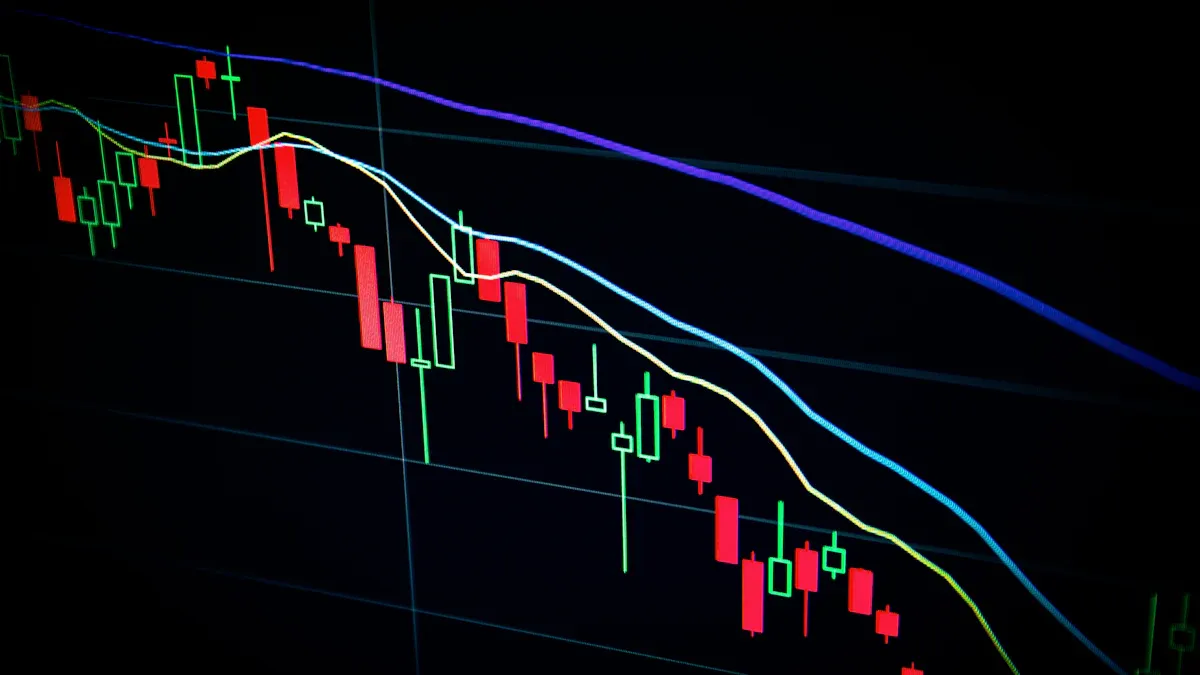- EasyCard
- Trade
- Help
- Announcement
- Academy
- SWIFT Code
- Iban Number
- Referral
- Customer Service
- Blog
- Creator
Bear Put Spread Strategy: A Detailed Guide to Steady Profit Techniques in a Declining Market

Image Source: unsplash
The bear put spread strategy can help you achieve steady profits with limited risk in a declining market. By reasonably pairing options contracts, you can lock in maximum losses and define a clear profit range. This strategy is defensive, with low transaction costs, suitable for investors seeking a safety margin. Through practical operations, you can flexibly respond to market fluctuations and improve investment efficiency.
Key Points
- The bear put spread strategy, through reasonable pairing of options contracts, helps investors achieve steady profits with limited risk in a declining market.
- The maximum loss of this strategy is limited to the initial net expenditure, ensuring investor confidence during market fluctuations and avoiding unlimited risk.
- Choosing appropriate options contracts and strike prices is the key to success; investors should pair them reasonably based on market expectations and their risk tolerance.
- When executing the strategy, investors can flexibly choose the timing to close positions to lock in profits or reduce losses, improving capital efficiency.
- The bear put spread strategy is suitable for investors seeking a safety margin, providing a clear profit range in uncertain market environments.
Advantages of the Bear Put Spread Strategy
Steady Profits
When you seek steady profits in a bear market, the bear put spread strategy can be your top choice. This strategy, through reasonable pairing of options contracts, allows you to achieve a clear profit range when the market declines. You can leverage the following advantages to enhance investment performance:
- The bear put spread strategy provides limited risk and potential profits, making it safer than other bearish options strategies.
- When the underlying asset price falls below the higher strike price, your trade begins to profit, with further declines yielding more profits.
- By precisely selecting strike prices and expiration dates, you can lock in maximum profits, avoiding significant losses due to sharp market fluctuations.
Professional Advice: You should pay attention to the liquidity and transaction costs of options contracts, choosing appropriate U.S. stock options to ensure smooth execution of the strategy.
Limited Risk
When operating the bear put spread strategy, you can effectively control risk. This strategy involves buying a put option with a higher strike price while selling a put option with a lower strike price, helping you limit potential losses. Specific advantages include:
- Your maximum loss is limited to the initial net debit (i.e., the USD amount paid for the strategy).
- Profit potential is capped within the range of the strike price difference minus the net debit, allowing you to clearly understand the profit and loss boundaries of each trade.
- You can confidently navigate volatile markets, avoiding the unlimited risk associated with single-leg put options.
By adopting the bear put spread strategy in a bear market, you can achieve steady returns while maintaining strict risk management. This strategy is ideal for investors seeking a safety margin and financial control.
Principles of the Bear Put Spread Strategy

Image Source: unsplash
Strategy Definition
When you expect the market to decline, you can adopt the bear put spread strategy. This strategy is widely recognized in financial literature, primarily achieved by simultaneously buying and selling put options with different strike prices to balance risk and reward. You buy a put option with a higher strike price while selling a put option with a lower strike price, both with the same expiration date. This allows you to achieve higher returns when the underlying asset price moderately declines while limiting maximum losses. The following table summarizes the definitions of this strategy by mainstream financial institutions:
| Source | Description |
|---|---|
| The Motley Fool | The bear put spread is an options trading strategy designed to capitalize on the expected decline in the value of a stock or index. The strategy has high return potential when the underlying asset value declines moderately. It limits investor losses while generating profits. |
| CapTrader | The bear put spread is an options strategy consisting of a purchased put option (long put) and a sold put option (short put) with a lower strike price, both with the same remaining term. This strategy is used in bearish markets. |
When implementing this strategy, you should prioritize selecting highly liquid U.S. stock options contracts to ensure smooth execution.
How It Works
The core of the bear put spread strategy lies in achieving dual limits on risk and reward through an options combination. You buy a put option with a higher strike price to gain profits from a decline, while selling a put option with a lower strike price to collect a premium and reduce costs, but this also caps the maximum profit. The strategy’s risk is limited to the net premium paid at opening, and the profit is determined by the strike price difference minus the net premium. The following table details the role of each component:
| Component | Description |
|---|---|
| Buy Put Option | This part drives profits, with the option value increasing as the underlying asset price declines. |
| Sell Lower Strike Put Option | This part caps maximum profits but offsets part of the purchase cost with the premium received. |
| Risk | The premium paid at opening limits the risk. |
| Profit | Higher strike price minus lower strike price minus the paid premium. |
| Breakeven | Higher strike price minus the paid premium. |
When operating in the U.S. market, you can clearly calculate the maximum profit, maximum loss, and breakeven point. This allows you to achieve steady profits in a bear market while strictly controlling risk.
Construction and Operation Process
Options Selection
When constructing the bear put spread strategy, you first need to select appropriate options contracts. Proper options selection can help you optimize the risk-reward structure. Here are common selection criteria:
- Based on your judgment of the underlying asset’s future trend, choose the strike price of a long-term put option. Typically, you can buy an at-the-money (ATM) or slightly in-the-money (ITM) put option to gain higher intrinsic value when the price declines.
- Simultaneously, sell a put option with a lower strike price (out-of-the-money, OTM) to reduce overall costs. This allows you to offset part of the purchase cost with the premium from the sold option.
- You should reasonably pair strike prices based on your risk tolerance and market expectations. Choosing an at-the-money strike price means taking moderate risk, while an in-the-money strike price is safer.
- The choice of expiration date is also critical. Longer-term options are typically more expensive but provide more time for the market to decline. Short-term options have lower costs but are more sensitive to time value erosion.
Professional Advice: When operating in the U.S. market, it’s recommended to prioritize highly liquid options contracts to ensure smooth transaction completion.
Trading Steps
When implementing the bear put spread strategy, you need to follow these steps:
- Select and buy a put option. For example, you can buy one put option for XYZ Corporation with a USD 30 strike price, expiring in three months.
- Simultaneously, sell one put option for XYZ Corporation with a USD 25 strike price, with the same expiration date.
- Calculate the total cost of the trade to determine the net expenditure. You pay the premium for the purchased option and receive the premium for the sold option, with the difference being the net debit.
- Clarify the maximum possible profit and risk. The maximum profit is the difference between the strike prices minus the net expenditure, and the maximum loss is the net expenditure.
- You can choose to close the position before expiration to lock in profits or reduce losses. If the underlying price is below the sold option’s strike price at expiration, you achieve the maximum profit.
The following table illustrates a typical operation process:
| Step | Operation Content | Purpose |
|---|---|---|
| 1 | Buy a high strike put option | Gain profits from a decline |
| 2 | Sell a low strike put option | Reduce costs, cap maximum profit |
| 3 | Calculate net expenditure | Clarify risk and cost |
| 4 | Set maximum profit and loss | Risk management |
| 5 | Close at expiration or earlier | Realize profits or stop losses |
Parameter Settings
When setting parameters for the bear put spread strategy, you need to focus on the following key points:
- The choice of strike prices directly affects risk and reward. Buying an at-the-money or in-the-money put option and selling a lower strike put option can increase the probability of profit in a declining market.
- The ratio of long and short options should be reasonably paired. Typically, a 1:1 ratio is used, but some investors may adjust the ratio based on market volatility to optimize the profit structure.
- Market conditions significantly impact strategy performance. In a low-volatility environment, the bear put spread strategy is more likely to achieve expected returns. You should execute the strategy during clear downtrends or price breakthroughs to leverage market momentum.
- The choice of expiration date should align with your capital allocation and market expectations. Longer expiration times help reduce risk, while shorter expirations may yield higher returns but require careful evaluation.
- Cost control and risk management are critical. You should allocate positions reasonably based on your financial situation, avoiding over-concentration in a single underlying asset or short-term contracts.
Professional Tip: When operating in the U.S. market, always monitor options liquidity and transaction costs, set parameters reasonably to ensure efficient strategy execution and controlled risk.
Case Study

Image Source: pexels
Operation Demonstration
When implementing the bear put spread strategy, you can refer to the following U.S. market case study. Suppose you are focusing on XYZ Corporation, with a current stock price of USD 120. You expect the stock price to drop to USD 110 within the next three months. You can take the following steps:
- Buy one put option with a USD 120 strike price and a USD 10 premium.
- Simultaneously sell one put option with a USD 110 strike price and a USD 4 premium.
- Your actual net premium paid is USD 6 (USD 10 - USD 4).
- At expiration, if XYZ’s stock price falls to USD 108, you can achieve the maximum profit.
The following table shows the complete strategy setup and results:
| Operation Step | Details |
|---|---|
| Stock Name | XYZ Corporation |
| Current Price | USD 120 |
| Expected Price | USD 110 |
| Buy Put Option | Strike price USD 120, premium USD 10 |
| Sell Put Option | Strike price USD 110, premium USD 4 |
| Net Premium | USD 6 |
| Breakeven Point | USD 114 |
| Final Price | USD 108 |
| Gross Profit per Share | USD 12 |
| Net Profit per Share | USD 6 |
Profit and Loss Analysis
Through the above case, you can clearly calculate the maximum profit, maximum loss, and breakeven point. The maximum profit is the strike price difference minus the net premium, i.e., USD 10 (USD 120 - USD 110) minus USD 6, equaling USD 4 per share. When XYZ’s stock price falls below USD 110, you achieve the maximum profit. The maximum loss is the net premium of USD 6, which is the actual cost paid at opening. The breakeven point is USD 114 (USD 120 - USD 6), where you neither gain nor lose if the stock price reaches this level at expiration. This approach allows you to lock in risk and profit ranges in advance, enhancing investment certainty.
Influencing Factors
Underlying Price
When using the bear put spread strategy, changes in the underlying asset’s price directly affect your final returns. When the asset price declines, the value of your purchased put option rises, while the sold put option helps reduce costs. You can refer to the following table to understand the impact of different price movements on strategy outcomes:
| Strategy Step | Description |
|---|---|
| Buy Put Option | Purchase a put option with a strike price slightly above the current market price. |
| Sell Put Option | Sell a put option with a strike price lower than the purchased put option. |
| Maximum Profit | Achieved when the asset price falls below the strike price of the purchased put option. |
| Maximum Loss | If the asset price is above the purchased put option’s strike price at expiration, the loss is limited to the initial cost. |
You profit when the underlying asset price declines, with maximum profit occurring when the price falls below the purchased put option’s strike price. If the price does not decline as expected, your maximum loss is limited to the net expenditure at strategy setup.
Volatility
When formulating the strategy, you must pay attention to the market’s implied volatility. Rising implied volatility increases options premiums, which helps enhance your profit potential. You can refer to the following table to understand the specific impact of volatility:
| Influencing Factor | Description |
|---|---|
| Implied Volatility | When implied volatility increases, options premiums rise, improving the strategy’s profitability. |
| Options Premium | Higher options premiums enhance the profit potential of the bear put spread. |
| Future Volatility | Future volatility (vega) is uncertain but significantly affects options pricing. |
When executing the bear put spread strategy in a high-volatility market environment, you can typically achieve a better cost structure and higher potential returns. You should closely monitor market volatility and adjust strategy parameters in a timely manner.
Time Value
When operating the bear put spread strategy, time value is another factor that cannot be ignored. The time value of options decreases as the expiration date approaches, affecting your strategy’s performance. Both the purchased and sold put options are subject to time value erosion. You need to reasonably select the expiration date to ensure sufficient time for the market to decline while avoiding excessive time value loss that reduces profits. By observing changes in options prices over time, you can optimize your holding period and improve overall strategy efficiency.
Risk and Reward
Maximum Profit
When using the bear put spread strategy, the maximum profit calculation is very clear. You can determine the profit ceiling through the strike price difference and the net premium paid. The specific formula is as follows:
| Component | Description |
|---|---|
| High Strike Option Price | The higher strike price of the option |
| Low Strike Option Price | The lower strike price of the option |
| Net Paid Premium | The total cost paid when purchasing the option |
| Maximum Profit Formula | High strike option price - low strike option price - net paid premium |
When operating in the U.S. market, if you buy a put option with a USD 120 strike price and sell a put option with a USD 110 strike price, with a net paid premium of USD 6, the maximum profit is USD 4 per share. You can achieve this profit when the underlying asset price significantly declines, but the profit will not grow indefinitely. You should carefully calculate the maximum profit before setting up the strategy to ensure clear profit goals.
Professional Tip: Before actual implementation, it’s recommended to use a table or calculator to estimate maximum profit to avoid errors in parameter settings affecting final returns.
Maximum Loss
When executing the bear put spread strategy, the maximum loss is always strictly limited. You only need to bear the initial cost invested, without worrying about unlimited risk. Specific details are as follows:
- The maximum loss equals the net cost paid at opening.
- If the underlying asset price is above both strike prices at expiration, your loss is limited to the initial investment.
- For example, if you pay USD 262 as the strategy cost and the underlying price does not fall below the strike prices at expiration, your maximum loss is USD 262.
You can further reduce potential losses by setting protective measures. You can consider rolling the strategy or adjusting the position structure in a timely manner. You can also monitor the option’s delta value and flexibly adjust the spread. You should reserve some capital to close positions promptly in adverse market conditions. You can use stop-loss orders or refer to signals from experienced traders to enhance risk control.
When operating in the U.S. market, always pay attention to initial costs and risk management to ensure every trade is within a controllable range.
Breakeven Point
When formulating the bear put spread strategy, the breakeven point is a key indicator for assessing the strategy’s effectiveness. The breakeven point is the underlying asset price at which you neither gain nor lose. You can calculate it using the following formula:
- Breakeven Point = High strike price - Net paid premium
For example, if you buy a put option with a USD 120 strike price and pay a net premium of USD 6, the breakeven point is USD 114. At expiration, as long as the underlying asset price falls below USD 114, you start to profit. You can flexibly adjust parameters based on market trends to optimize the breakeven point.
Professional Advice: During the strategy design phase, prioritize considering the breakeven point to ensure a reasonable risk-reward structure and improve overall investment efficiency.
Pros and Cons
Main Advantages
By adopting the bear put spread strategy in the U.S. market, you can gain multiple advantages. The following table summarizes the main benefits of this strategy for conservative investors:
| Advantage | Description |
|---|---|
| Limited Downside Risk | Through the combination of selling and buying options, the maximum loss is restricted to a specific range. |
| Balanced Position | This strategy mitigates the impact of time value erosion, suitable for conservative investors. |
| Maximum Profit | If the market price is below the lower strike price at expiration, you can achieve the maximum profit. |
You can lock in risk and profit ranges in advance by reasonably setting parameters. The strategy structure is simple, making it easy to adjust flexibly in actual trading.
Potential Disadvantages
The bear put spread strategy also has certain limitations. You need to pay attention to the following risk factors during implementation:
| Disadvantage | Details |
|---|---|
| Limited Profit Potential | The maximum profit is restricted to the difference between the two strike prices minus the net premium, which may not appeal to traders expecting significant price declines. |
| Requires Precise Market Timing | The strategy is most effective when you accurately predict a moderate decline in the asset price. If the price does not decline as expected, it may lead to losses. |
| Not Suitable for Strong Bearish Sentiment | If you expect a sharp decline in the asset price, a single-leg put option may be more appropriate as it offers unlimited profit potential. |
When formulating the strategy, you should consider your risk appetite and market judgment to avoid over-reliance on a single strategy.
Suitable Investors
You can determine whether the bear put spread strategy is suitable based on your investment goals and risk tolerance:
- You seek a risk-controlled investment approach with clear returns.
- You prefer to engage in options combination trading in the U.S. market to avoid extreme market fluctuations.
- You aim to achieve steady returns in a bear market with limited capital.
- You have basic options knowledge and can understand the strategy’s profit and loss structure and operational process.
Professional Advice: When choosing a strategy, prioritize your financial situation and market expectations, allocate positions reasonably, and improve overall investment efficiency.
Strategy Comparison
Bull Call Spread
When learning about the bear put spread strategy, you can also explore the bull call spread. Both strategies have similar structures, involving buying and selling options with different strike prices to balance risk and reward. In a bull call spread, you buy a call option with a lower strike price while selling a call option with a higher strike price. This allows you to achieve limited profits when the underlying asset price rises, with the maximum loss also limited to the initial net expenditure.
| Strategy Type | Risk Characteristics | Reward Characteristics |
|---|---|---|
| Bull Call Spread | Limited risk, maximum loss is the net premium | Limited profit, occurs under specific conditions |
| Bear Put Spread | Limited risk, maximum loss is the net premium | Limited profit, occurs under specific conditions |
You can see that both strategies help you lock in maximum losses, avoiding significant losses due to sharp market fluctuations. When choosing, you should judge based on market trends: use a bull call spread in a bullish market and a bear put spread in a bearish market.
Professional Tip: When operating in the U.S. market, it’s recommended to prioritize highly liquid options contracts to ensure smooth strategy execution.
Single-Leg Put
When considering the bear put spread, you may also explore a single-leg put option. A single-leg put involves buying only one put option without simultaneously selling another option. In a single-leg put, you can theoretically achieve unlimited profits as long as the underlying asset price continues to decline, increasing your returns. However, you need to pay a higher options premium, resulting in higher initial costs.
The main difference between the bear put spread and a single-leg put lies in the risk and reward structure. In the bear put spread, the maximum loss is strictly limited, and the profit range is clear. In a single-leg put, while there is higher profit potential, the initial cost and time value erosion are also greater. If you seek stability and controlled risk, the bear put spread is more suitable. If you predict a significant market decline and can tolerate higher risk, a single-leg put may be more appealing.
When implementing, you should combine your risk tolerance and market judgment to choose a strategy reasonably and improve investment efficiency.
By adopting the bear put spread strategy in the U.S. market, you can effectively hedge against downside risk and achieve clear returns. The following table shows that utilities and energy sectors perform steadily in bear markets, with significant EPS growth:
| Company Type | Q1 2025 Growth | EPS Growth | Future Growth Expectation |
|---|---|---|---|
| Energy | 9.3% | N/A | N/A |
| Utilities | 4.1% | 23% | 6-9% |
You should flexibly adjust the strategy based on market conditions:
- In a high implied volatility bear market, set more conservative trading parameters.
- Certain defensive industries may still perform well.
- As volatility rises, selling options can fetch higher prices.
By operating rationally and emphasizing risk management, you can improve investment efficiency in various market environments.
FAQ
Is the Bear Put Spread Strategy Suitable for Beginners?
You can easily get started with the bear put spread strategy. With basic options knowledge and by following the steps, you can achieve risk-controlled investment goals.
Can the Strategy Be Closed Early Before Expiration?
You can close the position early at any time. This allows you to lock in existing profits or reduce losses, flexibly responding to market changes and improving capital efficiency.
How Much Capital Is Needed to Implement the Strategy?
You only need to pay the net premium for buying and selling options. The actual capital requirement is low, making it suitable for investors with limited funds to try in the U.S. market.
Which Market Environments Is the Strategy Suitable For?
The strategy performs best when you expect a moderate decline in the underlying asset price. In bearish or volatile markets, the risk-reward structure is more reasonable.
How to Calculate Maximum Loss and Maximum Profit?
You can subtract the net premium from the strike price difference to calculate the maximum profit. The maximum loss equals the net premium paid at opening, with a straightforward calculation process.
You have now thoroughly mastered the Bear Put Spread strategy, recognizing how it provides a defensive advantage with limited risk and defined returns in a declining market. In options trading, execution efficiency and low-cost capital turnover are paramount, as any delay or high fee can erode the profits you lock in with precise strategies.
To ensure you can quickly buy and sell the options combination when the market shifts, and to avoid high cross-border remittance fees and opaque exchange rate losses, you need a financial platform that supports millisecond response times and same-day fund transfers for global markets.
BiyaPay is your essential capital accelerator for executing options spread strategies. We offer real-time exchange rate inquiry and conversion for fiat currencies, with remittance fees as low as 0.5%, and zero commission for contract limit orders, helping you maximize the net returns secured by your precise options combination. BiyaPay allows you to seamlessly convert between various fiat and digital currencies, and trade global markets, including Stocks, all on one platform. There is no need for a complex overseas account, and you can enjoy same-day remittance and arrival. Click the Real-time Exchange Rate Inquiry now, and BiyaPay for quick registration, and use peak capital efficiency to achieve steady profits in a bear market!
*This article is provided for general information purposes and does not constitute legal, tax or other professional advice from BiyaPay or its subsidiaries and its affiliates, and it is not intended as a substitute for obtaining advice from a financial advisor or any other professional.
We make no representations, warranties or warranties, express or implied, as to the accuracy, completeness or timeliness of the contents of this publication.




Contact Us
Company and Team
BiyaPay Products
Customer Services
is a broker-dealer registered with the U.S. Securities and Exchange Commission (SEC) (No.: 802-127417), member of the Financial Industry Regulatory Authority (FINRA) (CRD: 325027), member of the Securities Investor Protection Corporation (SIPC), and regulated by FINRA and SEC.
registered with the US Financial Crimes Enforcement Network (FinCEN), as a Money Services Business (MSB), registration number: 31000218637349, and regulated by FinCEN.
registered as Financial Service Provider (FSP number: FSP1007221) in New Zealand, and is a member of the Financial Dispute Resolution Scheme, a New Zealand independent dispute resolution service provider.



















